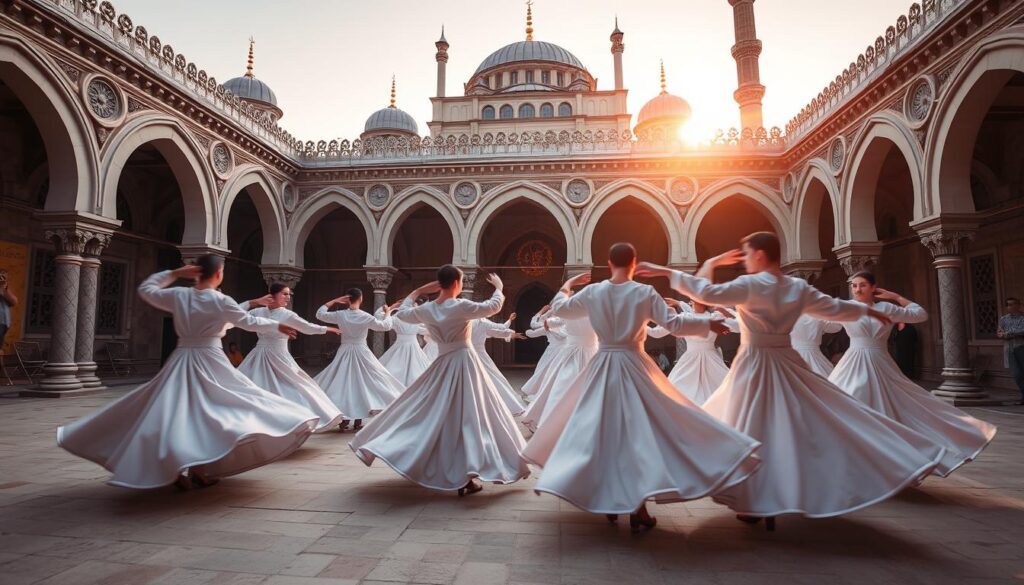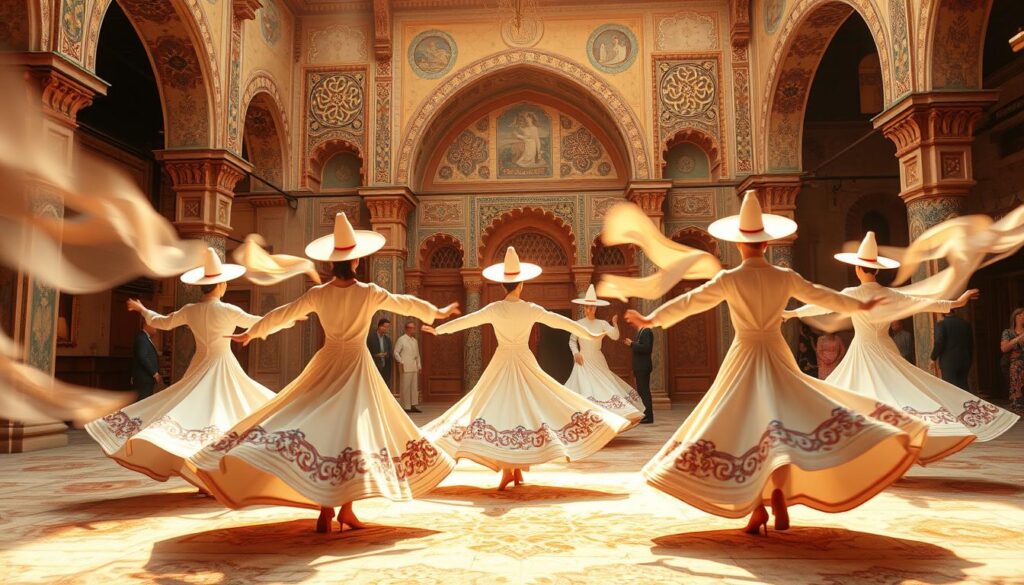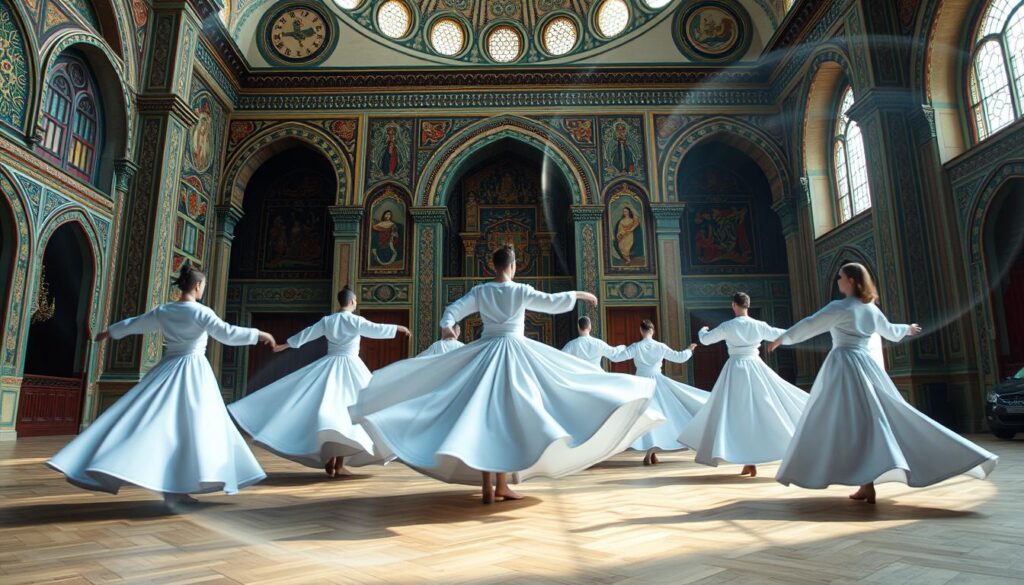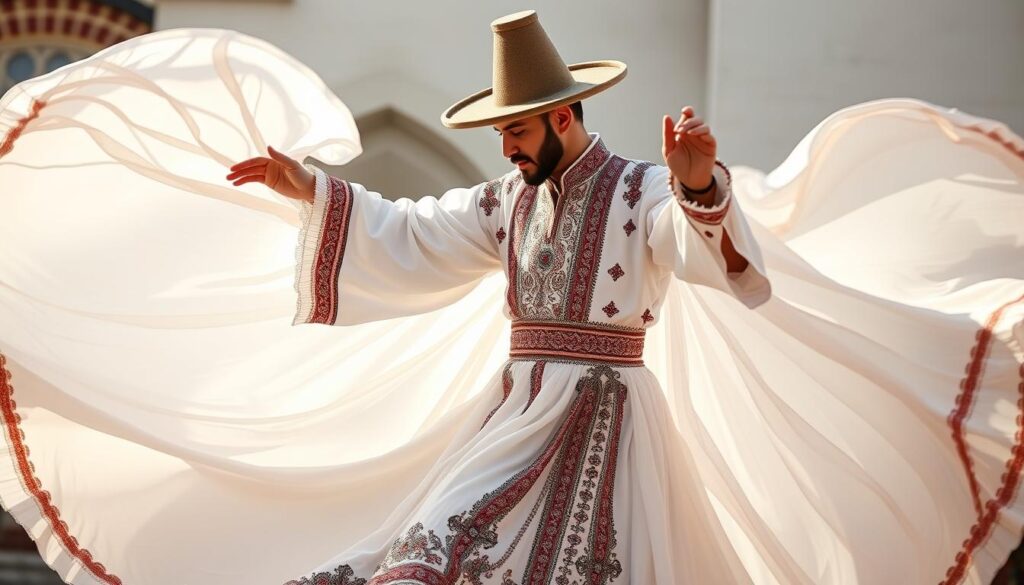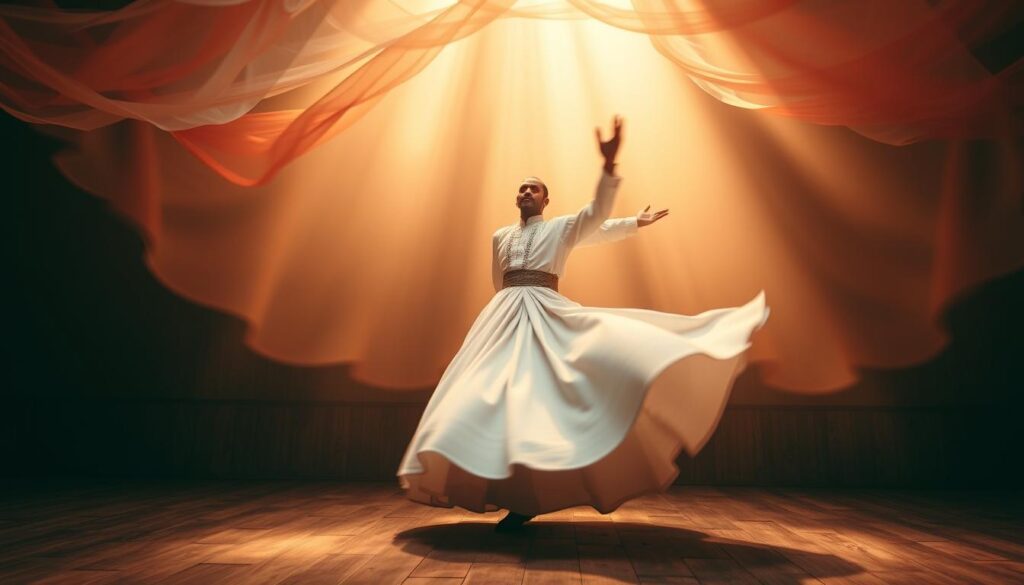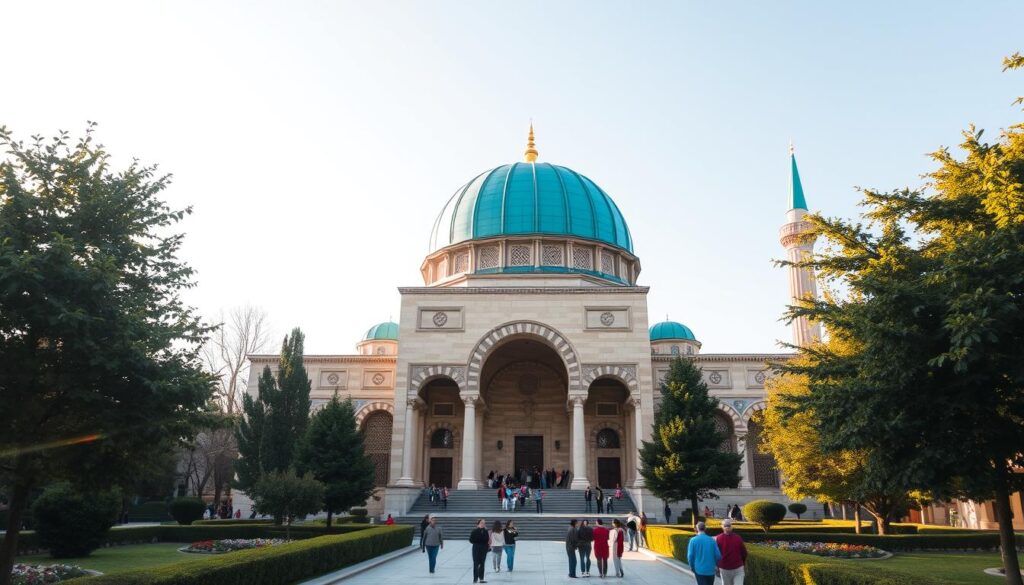As I entered the dimly lit hall, the scent of incense filled the air. The sound of chanting was soft. I was there to see the Whirling Dervishes, a tradition from Turkey’s Sufi mysticism. The sight was captivating – white-robed figures spinning, their movements in perfect sync with the music.
The Mevlevi Order, started by Jalal al-Din Rumi in the 13th century, protects this ritual. It’s a key part of Turkey’s culture. Watching the dervishes, I felt a sense of awe and connection. It was as if they were dancing with the divine.
Key Takeaways
- The Whirling Dervishes are members of the Mevlevi Order, a Sufi spiritual tradition originating in 13th-century Turkey.
- The mesmerizing Sema ceremony, with dervishes spinning in white robes, symbolizes a spiritual journey towards perfection.
- These performances are both a religious practice and a cultural heritage attraction, drawing tourists to cities like Istanbul, Konya, and Cappadocia.
- The Mevlevi Order and its traditions are recognized as an Intangible Cultural Heritage by UNESCO.
- Konya, the spiritual home of the Whirling Dervishes, hosts an annual Şeb-i Arûs festival commemorating Rumi’s life and teachings.
Understanding the Mevlevi Order and Sufism
The Mevlevi Order is a part of Sufism. It was started by followers of Rumi after his death in the 13th century. Sufism is a mystical part of Islamic spirituality. It focuses on love, tolerance, and worship of God. It also values community, self-discipline, and responsibility.
Origins of the Mystical Practice
The Mevlevi Order comes from Rumi’s teachings and his followers’ practices. In the Ottoman Empire, it grew beyond Turkey. It reached places like the Middle East, Egypt, and the Balkans. There, it shared the mystical acts of whirling and spiritual thinking.
Core Beliefs and Principles
- Devotion to God and the pursuit of divine love
- Emphasis on personal development and self-discipline
- Belief in the unity and equality of all people, regardless of belief, class, or race
- Commitment to serving the community and all creatures with compassion
Historical Development Through Ottoman Empire
The Mevlevi Order thrived in the Ottoman Empire. It produced famous poets, musicians, and scholars. They enriched the culture and art of their time. But in 1925, the Order was banned in the new Turkish Republic.
It wasn’t until 1954 that the Mevlevi could perform their Sema (whirling ceremony) again. This time, it was mainly for tourists.
“The purpose of Sema is to represent a spiritual journey towards Perfection through intelligence and love.”
The Story of Rumi and the Birth of Whirling
The whirling dance of the Dervishes, a captivating tradition rooted in Sufism, finds its origins in the life and teachings of Jalal al-Din Rumi, a 13th-century Persian poet, theologian, and Sufi master. According to legend, Rumi’s spiritual awakening occurred while he was walking among the Konya coppersmith workshops. The rhythmic clanging of tools and the invocation of God’s names inspired him to begin spinning in a state of ecstatic celebration.
This seminal moment is believed to have given birth to the practice of whirling as a form of 13th-century mysticism and meditation. The dervishes seek to attain a higher state of consciousness through rhythmic movement and spiritual contemplation. The Mevlevi Order, founded by Rumi himself, became the custodians of this sacred tradition, preserving and refining the art of whirling over the centuries.
“The Mevlevi Order, to which all whirling dervishes belong, was founded by Rumi.”
Today, the whirling dervishes continue to captivate audiences worldwide, with their mesmerizing performances. These performances serve as a testament to Rumi’s enduring legacy and the timeless allure of Sufi spirituality. From the streets of Konya to the global stage, the dervishes’ graceful, meditative dance remains a powerful embodiment of the search for divine connection, a cultural treasure that has endured for centuries.
Symbolism and Meaning Behind the Dervish Attire
The whirling dervishes of Turkey wear clothes full of spiritual meaning. Each part of the dervish costume shows their journey to enlightenment.
The White Gown (Tennure)
The tennure, a long white gown, stands for the dervish’s spiritual rebirth. It shows their readiness to leave earthly ties behind. This garment is a symbol of their spiritual growth.
The Black Cloak (Hirka)
The hirka, a black cloak, is worn over the tennure. It represents the dervish’s spiritual rebirth. When it’s removed, it shows their freedom from the material world.
The Traditional Headpiece (Sikke)
The dervish’s brown hat, called the sikke or kûlah, is very special. It symbolizes the dervish’s spiritual journey and the need to overcome ego. It reminds them of their spiritual path.
In the Sema ceremony, dervishes spin from right to left. They show love and compassion to all. Their spinning, along with their clothes, shows the beauty of Sufi tradition.
The Sacred Art of the Sema Ceremony
The Sema Ceremony is a captivating whirling ritual. It represents a person’s path to perfection through intelligence and love. The ceremony starts with a haunting reed flute solo. This calls the dervishes, dressed in black, to the stage.
As they remove their cloaks, they show their white tunics. Then, they start their mesmerizing whirling dance.
The dervishes dance to the rhythm of Ottoman court music. They spin with their right palms up, receiving God’s gifts. Their left palms face down, showing their wish to share these gifts with the world.
This dance is not just a show. It’s a deep spiritual journey. The dervishes aim to unite with the divine.
“The Sema ceremony is a representation of a person’s spiritual ascent through mind and love to perfection. In this ritual, the dervish’s camel hair hat (sikke) represents the tombstone of the ego; his black cloak (hirka) indicates the ego’s mortality, and when he takes off his cloak, he is spiritually reborn to reach the truth.”
The Sema Ceremony is a key part of the Mevlevi Order, also known as the Whirling Dervishes. It was started by Sufi mystic Mevlana Rumi in the 13th century. This ritual has amazed people for centuries with its mix of spirituality, art, and culture.
The Sema Ceremony deeply shows the Sufi tradition. Dervishes work hard to unite with the divine through whirling. This dance is more than a show; it’s a spiritual journey to connect with the divine.
Turkey’s Whirling Dervishes: A Cultural Experience
Today, whirling dervish performances have become both spiritual and tourist attractions. You can see real ceremonies in places like the Galata Mevlevi Hall in Istanbul. The Şeb-i Arûs festival in Konya is also a great place to watch.
But, some shows in Istanbul restaurants might not be real. They might not have the Mevlevi Order’s true performers.
Modern Performances and Tourism
In 2014, Rumi was America’s top-selling poet, even though he died over 700 years ago, the BBC reported. This interest has made cultural tourism grow. People want to see the whirling dervish rituals.
Every Monday night, Nurettin Efendi Dergahı in Istanbul holds a sama ceremony. It starts around 9 p.m. In summer, it can be as late as 11 p.m.
Authentic vs. Tourist Shows
Shows for tourists cost money, but real sama ceremonies are free. For example, Nurettin Efendi Dergahı’s ceremony is free. Women visiting must cover their hair, often from a latticed loft.
UNESCO Cultural Heritage Status
In 2008, the Mevlevi Sema Ceremony was added to UNESCO’s Intangible Cultural Heritage of Humanity list. This shows how important the whirling dervishes are. Their rituals have been kept alive for generations, influencing Turkey’s art and spirituality.
“The rituals established within the Mevlevi order, where whirling dervishes originated, involve spiritual introspection through poetry, chants, music, and dance.”
Going to a sama ceremony teaches you about the whirling dervishes’ role in Ottoman culture. It shows their impact on arts, music, poetry, and calligraphy. The article says this is a true Sufi worship experience, unlike shows for tourists.
The article also says Konya is the best place to see real whirling dervishes. But Istanbul also has authentic performances.
Konya: The Spiritual Home of Whirling Dervishes
Konya is in the heart of Turkey and is the spiritual center of the Whirling Dervishes. It’s the sixth-largest city in the country. Here, the Mevlevi Order, founded by Rumi, has thrived for centuries.
The Mevlana Museum is at the heart of Konya. It has Rumi’s 13th-century mausoleum. The museum’s turquoise-tiled dome is famous worldwide.
Inside, Rumi’s tomb is covered in green velvet and gold. It shows his lasting impact.
Konya also has the Selimiye Mosque, a UNESCO World Heritage Site. It has tall minarets and a rich history. Sometimes, it hosts Whirling Dervishes performances.
“Konya is the Turkish equivalent to America’s Bible Belt, known for its serious practice of Islam and scarcity of alcohol.”
Konya is a center for those interested in the Whirling Dervishes. The Rose Garden of the Mevlana Museum and the Selimiye Mosque are must-sees. They leave a deep impression on visitors.
The Şeb-i Arûs Festival Experience
Every year, Konya, Turkey, lights up with the Şeb-i Arûs festival. It honors Mevlana Jalaluddin al-Rumi, a famous Sufi scholar from the 13th century. This Rumi commemoration event, from December 7 to 17, draws people from all over. They come to dive into the spiritual side of the December festival and spiritual tourism.
Annual Celebrations
The 750th Şeb-i Arûs ceremonies are happening in Konya. It’s a big deal for the city’s culture. The festival has symposiums, concerts, exhibitions, and workshops. All are to celebrate Rumi’s deep impact.
Festival Highlights and Activities
- The Sema Ayin-i Şerifi, or the Semah ceremony, is the main event. Whirling dervishes dance to Sufi music, captivating everyone.
- The UNESCO-recognized Mevlânâ Museum in Konya is a must-see. It shows the life and work of the famous Sufi mystic.
- The Tomb of Shams Tabrizi, linked to Rumi, is a key spot during the festival. Visitors come to feel the spiritual vibe.
- The Mevlânâ Cultural Centre hosts the Sema Ayin-i Şerifi and other performances. It’s a place to celebrate Rumi’s teachings.
The Şeb-i Arûs festival honors Rumi’s legacy. It’s a time for Rumi commemoration, December festival, and spiritual tourism. It shows how these can unite people in a shared love for the divine.
Where to Watch Authentic Dervish Performances
Turkey is a great place to see the Whirling Dervishes’ Sema ceremony. In Istanbul, the Hodjapasha Dance Theater is a top spot. It’s in a 550-year-old hammam. Here, you can watch Whirling Dervish shows on Tuesdays, Thursdays, and Saturdays during the low season. They have daily shows starting in March.
For a deeper experience, head to Cappadocia. Sema ceremonies happen at places like the Sarihan Caravanserai. But, Konya is the best place to see the Dervishes. It’s where the Mevlevi order was born. The Şeb-i Arûs festival, celebrating Rumi, is a special time to see the Dervishes.
It’s smart to book tickets early, especially for busy times. The Sema ceremony is a UNESCO-protected tradition. It’s a mesmerizing experience that brings you close to Sufi spirituality.
